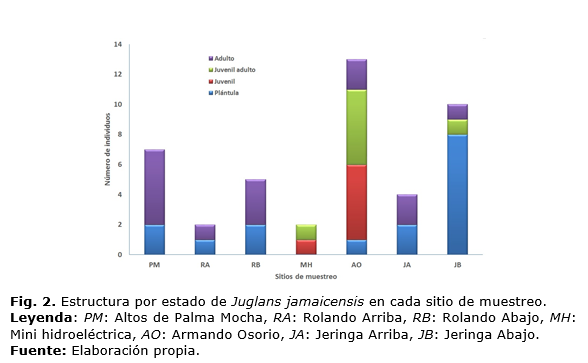Diametric and status structure, mortality and recruitment of Juglans jamaicensis C. DC., in the Turquino National Park
Main Article Content
Abstract
Downloads
Article Details
References
· ACOSTA H. et. al. Efecto del aprovechamiento forestal sobre la variación morfológica de Juglans pyriformis Liebm. Revista Chapingo. Serie Ciencias Forestales y del Ambiente, 2011,17(3), 379-388
· ALETÁ, N.; NINOT, A. Y VOLTAS, J. Caracterización del comportamiento agroforestal de doce genotipos de nogal (Juglans sp.) en dos localidades de Cataluña. Invest. Agrar.: Sist. Recur. For., 2003, 12(1), 39-50
· BERAZAÍN I. R. Lista roja de la flora vascular cubana. Ayuntamiento de Gijón y Jardín Botánico Atlántico de Gijón. 2005.
· BERGMANS, F. Y VROOMANS, V. Disponibilidad y sostenibilidad de recursos forestales: una investigación sobre la estructura y composición de especies de un bosque del norte de la Amazonía Boliviana y su disponibilidad de recursos actual y futura. Tesis de maestría inédita, Universidad Técnica del Beni, 1995.
· BETANCOURT B., A. Silvicultura especial de árboles maderables tropicales. La Habana: Científico Técnica. 2000.
· BIBB, K. Y MONSEGUR, O. A. Nogal or West Indian Walnut (Juglans jamaicensis). 5-Years Review: Summary and Evaluation. US, Fish and Wildlife Service Southeast Region Caribbean Ecological Services Field Office Boqueron. Puerto Rico. 2013.
· CEDEÑO P. R. La noche más larga. Memorias del huracán Sandy. Santiago de Cuba: Santiago. 2014.
· CONDIT, R.; HUBBELL, S. P. Y LAFRANKIE, J. V. Species-area and species-individual relationship for tropical trees: A comparison of three 50-ha plots. Ecology, 1996, 84, 549-562
· FAO. Material forestal reproductivo. Centro de Seguimiento de la Conservación Mundial del PNUMA (WCMC). 2013.
· FELFILI, J. M. Y SILVA J. M. C. Distribuição dos diâmetros numa faixa de cerrado na Fazenda Água Limpa (FAL) em Brasília, DF. Acta Botanica Brasilica, 1988, 2, 85-104.
· FORS, A. J. Manual de Selvicultura. La Habana: INDAF. 1967.
· FRANCIS, J. K., Y ALEMAÑY M., S. Juglans jamaicensis C. DC. Nogal. SO-ITFSM-73, New Orleans, LA: U.S. Department of Agriculture. Forest Service, Southern Forest Experiment Station. 1994.
· FREDERICKSEN, T. Y MOSTACEDO, B. Regeneration of timber species following selection logging in a Bolivian tropical dry forest. Forest Ecology and Management, 2000, 131, 47 55.
· GOMES, E. P. C. Dinâmica do componente arbóreo de um trecho de mata en São Paulo, SP. Tesis doctoral inédita. Instituto de Biociencias. Universidad de São Paulo, 1998.
· GONZÁLEZ R., B. Tree species diversity and regeneration of Tropical Dry Forest in Nicaragua. Tesis doctoral inédita, Universidad Suiza de Ciencias Agrícolas. Sw. Acta Universitatis Agriculturae Sueciae, 2005.
· HARPER, J. L. Population biology of plants, New York: Academic Press, 1990. JANZEN, D. H. Herbivores and the number of tree species in tropical forests. American Naturalist, 1970, 104(940), 501-528.
· KEELY, J. E. Demographics structure of California Black Walnut (Juglans californica, Juglandaceae) woodlands in Southern California. Madroño, 1990, 37(4), 237-248.
· LAMPRECHT, H. Silvicultura en los Trópicos. Los ecosistemas forestales en los bosques tropicales y sus especies arbóreas posibilidades y métodos para un aprovechamiento sostenido-. República Federal de Alemania: Cooperación Técnica. 1990.
· LASTRES A. I.; HERNÁNDEZ R., P. Y GÓMEZ T., J. M. Área Protegida Parque Nacional Turquino. Plan de Manejo 2011-2015, 2011.
· LIEBERMAN, D. Y LIEBERMAN, M. Forest tree growth and dynamics at La Selva, Costa Rica (1969-1982). Journal of Tropical Ecology, 1987, 3(No. Especial), 347-358.
· LIEBERMAN, D. Y et. al. Small-scale altitudinal variation in lowland wet tropical forest vegetation. Journal of Ecology, 1985, 73, 505-516.
· LÓPEZ, M. A. Population structure of Eschweilera coriacea (DC.) S. A. Mori in forest fragments in eastern Brazilian Amazonia. Revista Brasil. Bot., 2007, 30(3), 509-519.
· LUNA V. I et al. Biogeography, current knowledge and conservation of threatened vascular plants characteristic of Mexican temperate forests. Biodiversity and Conservation, 2006, 15, 3773-3799.
· MARTÍNEZ, M. Regeneración natural de especies arbóreas en selvas húmedas. Boletín de la Sociedad Botánica de México, 1994, 54, 179-224.
· PEREIRA B., W. Y LIMA R., M. DE S. Estrutura espacial e diamétrica de especies arbóreas e seus condicionantes em um fragmento de cerrado sentido restrito no sudoeste goiano. Hoehnea, 2010, 37(2), 181-198.
· POORTER, L. Y HAYASIDA, O. Effects of seasonal drought on gaps and understorey seedling in a Bolivian moist forest. Journal of Tropical Ecology, 2000, 16, 481-498.
· RISCO R. E Ecología, Fitogeografía y Tipología Forestal de las selvas, bosques y matorrales cubanos. Texto para la Maestría en Ciencias Forestales. Universidad de Pinar del Río, 2005.
· ROCHA, M. M. DA. Demografía de árvores em floresta pluvial tropical atlântica, Ilha do Cardoso, SP. Brasil. Tesis doctoral inédita. Universidad de Sao Paulo, 2000.
· RODRIGUEZ S., J. L.; BARRERO M., H. Y AGUILAR E., C. Morfometría de Juglans jamaicensis, y su conservación en el Parque Nacional Turquino, Granma. Avances, 2014, 16(2), 107-114.
· SHEIL, D.; BURSLEM, D. F. R. P. Y ALADER, D. The interpretation and misinterpretation of mortality rate measures. Journal of Ecology, 1995, 83, 331-333.
· SILANDER, S. Recovery plan for Juglans jamaicensis (Nogal or West Indian Walnut). U. S. Fish and Wildlife Service Atlanta, 1999.
· WRIGHT, S. J.; MULLER L., H. C.; CONDIT, R. Y HUBBEL, S. P. Gap-dependent recruitment, realized vital rates, and size distributions of tropical trees. Ecology, 2003, 84, 3174-3185.


